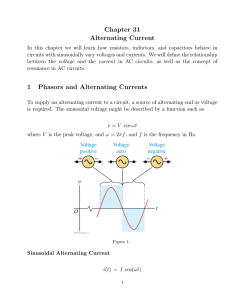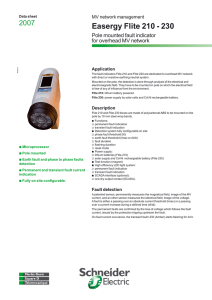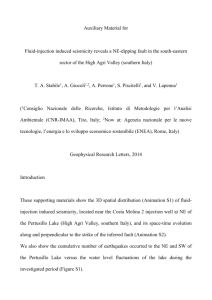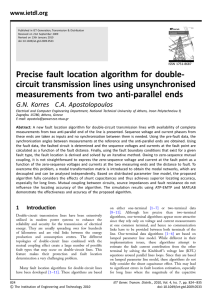L24 - Electrical and Computer Engineering
advertisement
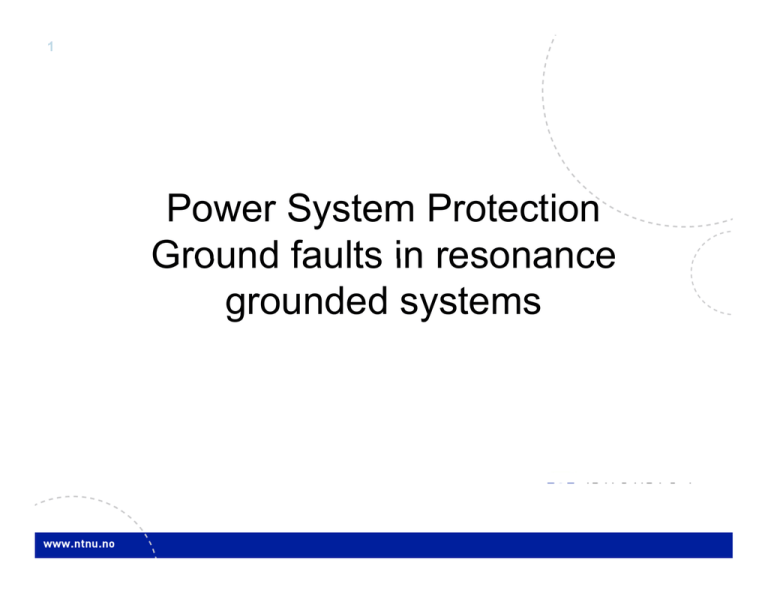
1 Power System Protection Ground faults in resonance grounded systems 2 Briefly about the speaker • Professor at Norwegian Univ. Science and Technology – Dept. Electrical Engineering – Power system transients and protection – High Hi h voltage lt engineering, i i stress t calculations l l ti – Recent focus on Power Transformers • Developer of ATPDraw • Sabbatical at MTU – Room 628 628, phone 487 487-2910 2910 – hhoidale@mtu.edu 3 Solid vs. resonance neutral + No over-voltages in fault situations - High Hi h ffault lt currentt + Easy fault detection + G Ground ou d faults au s pe persist ss • Fast trip and reclosing - Poor power quality - Extra stress - Undefined voltages to ground. High at resonance. + Ideally zero fault current. Arc self-extinguish. - Difficult fault detection/location. Requires special competence and maintenance. - In dynamic systems the coil must adapt. Expensive equipment equipment. + Can continue to operate during ground fault. Increased power q quality. y • Safety issues: down/broken conductors 4 How can be reduce fault current further from isolated neutral systems? • Compensate capacitive current with inductive. • Resonance principles: I C L + V - 1 V I V j C 1 2 LC j L j L At resonance (2LC=1) the current is zero L= (3Cg)-11 Cg 5 Usage of resonance grounding Dy Dy • In Norway – MV system y 12-24 kV – Distribution level 66-132 kV • Self-tuning Peterson coils used • Weather conditions result in a lot of temporary ground fault • Power quality is very important to the industry – Fast trip & reclosing not acceptable • Increasingly a preferred solution in Europe 6 Zero sequence measurements • Current I0: Sum Ia, Ib, Ic – Summing the current numerically – Residual connection – Summation transformer (Toroidal/Rogowski coil) 3I0 3I0 I0 Lower accuracy due to CT differences • Voltage V0: Sum Va, Vb, Vc – Open delta 3V0 – Neutral point (isolated or resonance earth) V0 7 Resonance grounding • Inductance added in the neutral point • Compensate for the capacitive current through Cg; help the arc self extinguish • The coil can be automatically tuned when the system changes (Petersen-coil (patent from around 1920) – Adjust air gap – The coil changes it value incrementally and notice how the neutral voltage changes. From a theoretical curve the resonance point is estimated. • Over-compensation preferred to limit VN – Avoid resonance also when parts of the system become disconnected • The unit Ampere is used to quantify the coil; IL=Vp/L 8 Variable inductance N • Adjust air gap hVpa h2Vpa Vpa TRENCH L C Increases with asymmetry and resistance VN Normal point of operation R Resonance IL~1/L 1/L No-fault situation 9 First attempt to analyze the neutral voltage • Need to know: Maximum neutral voltage in normal operation. Set U0 pick-up above this limit N hVpa h2Vpa Vpa L 3I0 I a (V N V pa ) j C I b (V N h 2 V I c (V N h V pa pa ) j C ) j C 3 I 0 ( I a I b I c ) V N j 3C C VN 0 ?? j 3C 1 / j L • At resonance j3C+1/jL=0 and the neutral voltage becomes undefined undefined… (→ ∞)) • Need to add sophistication here… V N j L 10 Effect of asymmetry and conductive line charging N Increases with asymmetry and resistance hVpa h2Vpa VN Vpa L G C Normal point of operation C+C Under-comp. Over-comp. I a (V N V pa I b (V N h 2 V I c (V N h V Resonance ) (G j C ) pa pa No-fault situation ) (G j (C C )) ) (G j C ) 3 I 0 ( I a I b I c ) 3V N ( G j C ) (V N h 2 V VN h 2 V pa j C 3G j 3C j C 1 / j L VN pa ) j C Vp VN s d 1 j u u V N j L ,m ax V p C 3G IL~1/L 11 Resonance grounded system d i fault during f l ((L=constant)) • Equivalent circuit (fault phase A) Vpa N + 3G L 3Cg VN V0 A If Rf V pa jL jL R f (1 L 3C g ) 2 If V ppa (1 2 L 3C g ) jL R f (1 2 L 3C g ) Vpa at resonance, also for large Rf • In reality asymmetry (C) and conductive elements (G||1/Rf) affect fault current and VN • A resistance across L is often actively connected to “find” the fault (identify faulty feeder) 12 Example of neutral voltage • From ATP simulations – In reality the resonance peek is typically lower – …and measurements are required 35 Stay away from this resonance area Neu utral voltage [kkV]rms 30 LCC 100 k 50. km LCC LCC LCC 50. km 50. km 20 Fault 0k 15 Fault 3k 10 No‐fault 1 pu 5 U Y 25 Normal point of operation V SAT 50. km 1 M WRITE max min 0 0 0.1 nF 0-3k 2 4 6 8 10 12 Coil "current" [A] 14 16 18 20 13 Directional over-current relay – resonance grounded d d systems • Start when V0 goes above a fixed limit; premeasure the coil response max(VN,healty); • After a delay connect resistor R (|| to L) • Trip if current I0 enters trip zone (2nd quadrant) • Trip zone set based on natural conductive current and asymmetry I01 -I0 I02 I0CG I03 R L For each feeder I0L V0 V0 G VN C I0R Trip zone H lth Healthy IL 14 Trip zone • The resistive component of I0 (in phase with V0) is used -II0 -II0 Trip zone I0CG V0 For each feeder I0L V0 R Healty feeder R Faultyy feeder I0CG 3 I 0 i ( I ai I bi I ci ) V 0 (3G i j 3C i ) Angle quite close to 90° I0R T i zone Trip 3 I 0 i ( I ai I bi I ci ) V 0 ( 3 G i j 3 C i ) (V 0 V pa )/ R f 1 V 0 3(G t G i ) j 3(C t C i ) j L 15 Relaying logic • Is zero sequence voltage above threshold? – V0>Vlim (type 59G over-voltage relay) • Is zero sequence current above threshold and in correct quadrant (4th)? – I0>Ilim I0 Ili (type (t 67N di directional ti l over-currentt relay) l ) + 59G (V0>Vlim) - 67N (I0>Ilim) 52 trip 16 Wave/Wischer relays • Used in the 132 kV resonance earthed system y • Measure the transient surge and use time of arrival principles • Communication required • Trip the two relays that first identify the fault • Sensitive S i i to di disturbances b lik like lilightning h i
